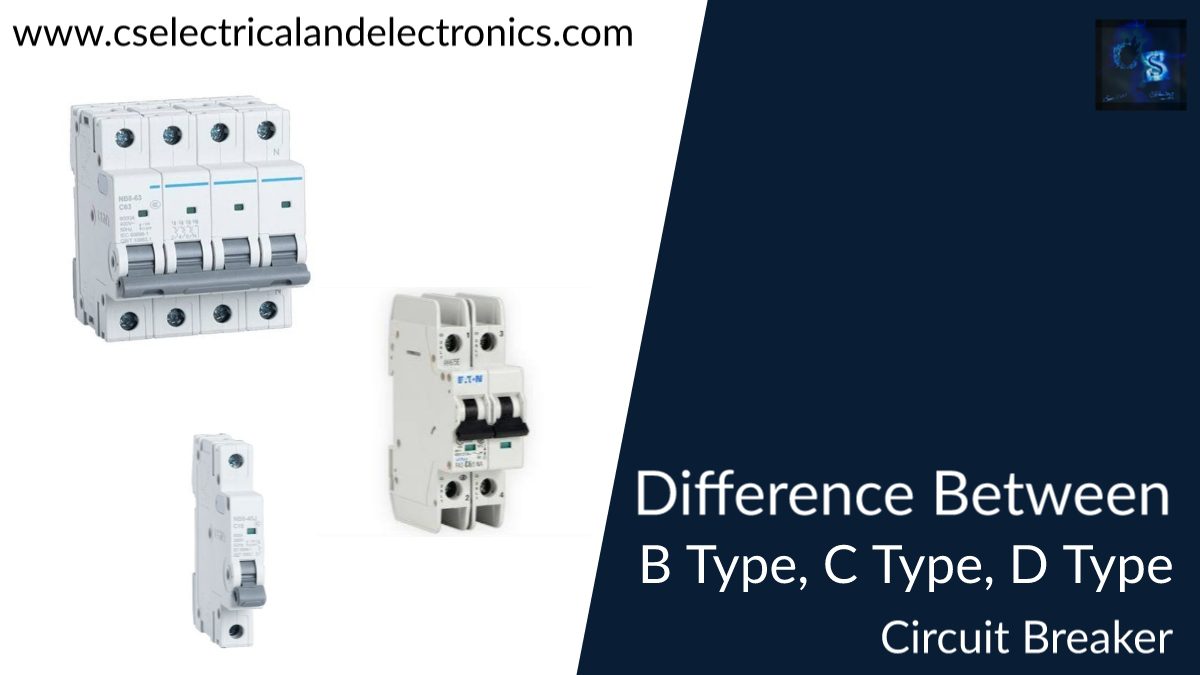Difference Between B Type, C Type and D Type Circuit Breaker
Hello guys, welcome back to our blog. In this article, we will discuss the difference between B type, C type, and D type circuit breaker, what is b type circuit breaker, what is c type circuit breaker, and what is d type circuit breaker.
If you have any electrical, electronics, and computer science doubts, then ask questions. You can also catch me on Instagram – CS Electrical & Electronics.
Also, read:
- What Is SoC In Battery, State Of Charge, Methods, Purpose
- What Is SoE In Battery, State Of Energy, Methods, Purpose
- What Is SoF In Battery, State Of Function, Methods, Purpose
B Type, C Type and D Type Circuit Breaker
First, I will discuss what the circuit breaker is. A circuit breaker is a device or equipment which can,
- Make or interrupt a circuit either manually or by remote control under normal conditions.
- Break a circuit automatically under fault conditions.
- Make a circuit either manually or by remote control under short circuit or overload conditions.
C Type Circuit Breaker
How to identify a type c circuit breaker? If you buy 32 Amps circuit breaker from the market front side there will be printed as C 32 by seeing this you can easily identify a c-type circuit breaker.
The c-type circuit breaker has a minimum tripping current of 5 to 10 times the rated current (for example: assume the rated current of the circuit breaker as 5 amps when 25 amps current flow through the circuit breaker it will trip). Now let’s see the applications of a c-type circuit breaker, this type of circuit breaker is used for loads with a moderate inductive component that uses low-hp motors or specific types of lighting like air conditioners, residential or commercial pumps, fans, and also lighting which uses ballasts with an inductive component.
B Type Circuit Breaker
How to identify a type b circuit breaker? If you buy 32 Amps circuit breaker from the market front side there will be printed as B 32 by seeing this you can easily identify a b-type circuit breaker.
The b-type circuit breaker has a minimum tripping current of 3 to 5 times the rated current (for example: assume the rated current of the circuit breaker as 5 amps when 15 amps current flow through the circuit breaker it will trip). The b-type circuit breaker is used for purely resistive loads or loads with a very small inductive component.
The purely resistive loads are the loads that use heating elements such as the heater, toaster maker, etc. This is also used in lighting circuits (non-inductive) and also for general purpose outlets.
D Type Circuit Breaker
The d-type circuit breaker has a minimum tripping current of 10 to 20 times the rated current. This circuit breaker is used for loads with a very high inductive component, typically found in industrial settings.
This type of circuit breaker is connected with large induction motors or transformers, X-ray equipment, and welding equipment.
This was about “B Type, C Type and D Type Circuit Breaker“. I hope this article may help you all a lot. Thank you for reading.
Also, read the following:
- 10 Tips To Maintain Battery For Long Life, Battery Maintainance
- 10 Tips To Save Electricity Bills, Save Money By Saving Electricity
- 100 (AI) Artificial Intelligence Applications In The Automotive Industry
- 100 + Electrical Engineering Projects For Students, Engineers
- 1000+ Automotive Interview Questions With Answers
- 1000+ Control System Quiz, Top MCQ On Control System
- 1000+ Electrical Machines Quiz, Top MCQs On Electrical Machines
- 1000+ MATLAB Simulink Projects For MTech, Engineering Students


Hi, after reading this awesome piece of writing i am as well happy to share my know-how here with colleagues.
I was very happy to find this web site. I want
to to thank you for your time just for this wonderful read!!
I definitely liked every part of it and I have you bookmarked to look at new information in your
site.